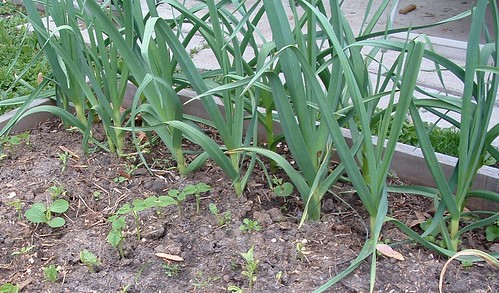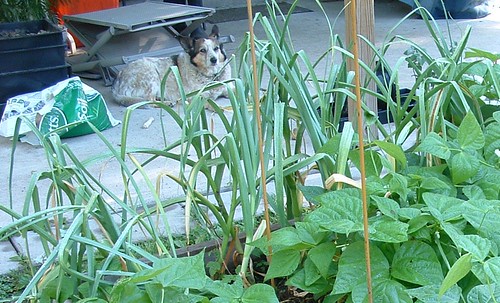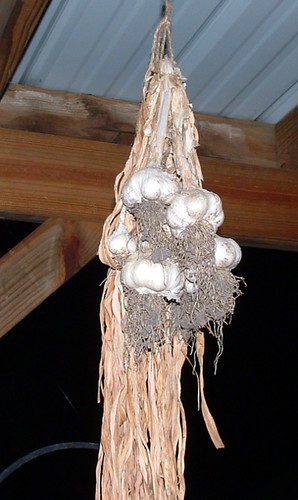Big Garlic Harvest
I haven’t posted much about the garden lately. I guess it hasn’t seemed that interesting—just harvesting things and wishing it would dry out a little—but I’ll try to catch up on that soon. We did finish our garlic harvest, though, so here are some pictures of that.
We got two mild softneck varieties from Hood River Garlic, a small family-run organic garlic seller in Oregon. They sell a bunch of different varieties, and they’ve got a nice web site with lots of information about garlic: how to grow it, recipes for using it, and other stuff. We didn’t get it planted until after Thanksgiving, which was probably late for this area. But every clove came up looking great and growing fast in the spring.
In June, they started sending up “scapes,” which are a hard shoot that comes out of the center and later forms a bulb on the end. This is a seed, so if you don’t cut it off, the plant will take energy out of the root bulb and put it into this seed. So you have to cut off the scapes, and they can be used like garlic-flavored green onions. By the middle of July, some of the leaves were starting to turn brown, which is the signal that it’s ready to harvest. Here’s a picture from when they were just starting to turn.
A couple weeks after that, we harvested them, which meant loosening the soil a little with a shovel and pulling up the whole plant. We knocked off some excess dirt, tied them in bunches with twine, and hung them from the porch to dry. This drying process is also called “curing.” After a couple weeks, they looked like this.
When we were sure the stems and roots were completely dry, we got them ready for storage. Each stem is cut off about an inch from the bulb, and the roots are cut off 1/4-inch long and any clumps off dirt gently knocked loose. A little dirt doesn’t hurt anything while they’re in storage; the most important thing is not to damage the skin, so they’ll stay good. With that done, they look like this, and are ready to be put in a paper sack or something that can breathe, and stored in a cool, dark place.
We learned a couple things this first year. For one, we probably should have started them sooner, so they’d have a chance to get a bigger root system established before shutting down for winter. It got pretty cold soon after we planted them, so I put some plastic over them to hold in some heat, but I think an extra month’s growth would have helped them out. I also think our soil was probably too rich. Our beds are at least half compost, and garlic (and onions) like a sandier, bleaker soil. Rich soil is good for the green parts of plants, but not so good for the roots, it seems. This fall, we should probably mix some sand or vermiculite into the soil where we plant the garlic. (And do the same for carrots next year.)
I think those two things were the reason our bulbs are quite a bit smaller than the ones they sent us to plant. We probably still wound up with 4-5 times the amount of garlic we planted, though, so that’s not bad for a first try. It’s good stuff, too; even after being cured it has a lot more moisture than the garlic you normally get from the store, so it minces well and has a lot of aroma. It’s pretty mild, but that’s what we ordered, because we didn’t know where the store-bought garlic fell on the mild-strong scale. Next time we might experiment with some stronger varieties.
If you enjoyed this article, why not rate it and share it with your friends on Twitter, Facebook, or StumbleUpon?
loading...




